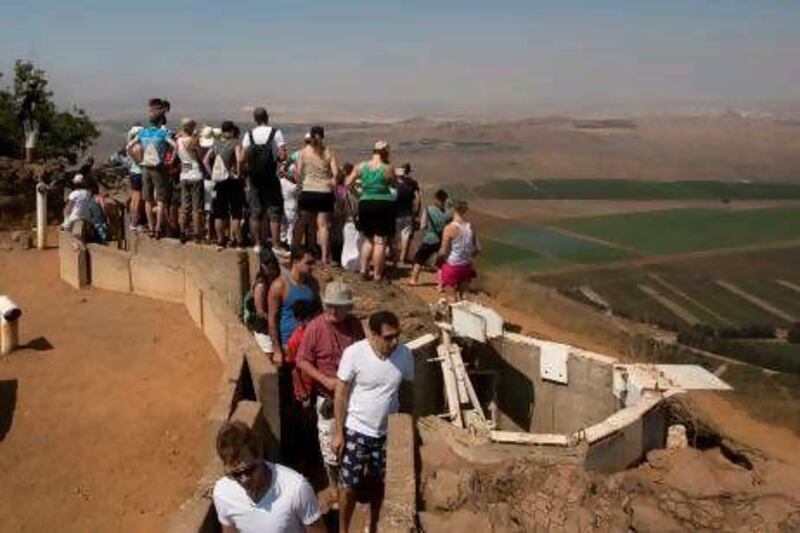GOLAN HEIGHTS // When they are not hiking or admiring bucolic vistas that stretch deep into Syria, tourists here can explore intact bunkers still covered in barbed wire or decommissioned Israeli tanks collecting rust in these fields.
They are relics of wars that engulfed the Golan Heights in the late 1960s and early 1970s, back when the UAE was newly independent and Arab states still fielded conventional armies against Israel.
They also are testaments to the relative tranquillity that has settled over this strategic plateau since 1973, when Israel and Syria last battled to control it. Lately, however, echoes of conflict have punctured the air. Last month, residents of Majdal Shams had to brace themselves because of mortar explosions just beyond the 1974 ceasefire line. The Syrian military had been attacking a village for several nights.
"My windows were rattling," said Salman Fakherdeen, an activist who recalled listening to the explosions from his office.
It was the closest brush yet with Syria's civil war for this community, on the northernmost fringe of the Israeli-occupied Golan Heights, which it captured from Syria during the 1967 Arab-Israeli war.
Although not directed at Israel, the bombardments have jolted Israeli officials. During a tour with military officials here in July, Ehud Barak, the defence minister, listened to the thumps reverberating over the boundary.
"It is getting closer," he remarked.
That may not only have been a reference to attacks by the military of Syrian President Bashar Al Assad that have killed more than 20,000 people since an uprising against his rule began 18 months ago. It may also have been a prediction for the Syrian leader himself.
To be certain, Mr Al Assad's removal would not be celebrated in the corridors of power in Israel. Over the last four decades, its boundary with Syria, which runs through the Golan, has been notable for, above all, quiet.
The countries are of course still bitter enemies, and Syrians, affronted by Israeli control of the Golan, consider reclaiming the area a national priority.
But the Syrian president and his father, Hafez, who ruled with an iron fist until his death in 2000, refrained for decades from trying to use force to take back the Golan Heights.
Successive military defeats forced the conclusion that fighting Israel head-on was an unwinnable strategy, convincing Damascus to turn to indirect confrontation by aiding anti-Israel groups such as Hizbollah in Lebanon and the Palestinian Islamists of Hamas.
Now, with Mr Al Assad's grip on power slipping, Israelis here fear novel challenges such as refugee inflows and havens for radical Islamists.
"The future there is Al Qaeda, a new Pakistan," said David Barel, 63, manager of Hunters Lodge hotel in Neve Ativ, one of about 30 Israeli settlements in the Golan Heights.
He wondered whether Israel would - or even could - negotiate a deal with Syria that would swap with it the Golan Heights for a peace agreement.
Israeli prime ministers from Yitzhak Rabin, Ehud Barak and Ehud Olmert had put forward the idea.
During his first tenures as prime minister in the 1990s, Benjamin Netanyahu, an arch supporter of settling territories occupied by Israel, recruited American businessman Ronald Lauder to broach the issue with Hafez Al Assad in 1998.
While Israel draws about a third of its water from the Golan Heights, the area lacks the biblical resonance of the West Bank and East Jerusalem, also occupied by Israel since 1967.
Yigal Kipnis, a historian at the University of Haifa, blamed the failure of past efforts to trade the Golan Heights on "emotions, nothing else".
This was because of squabbles over the 1923 boundary that, carved out by imperial France and Britain, Israelis and Syrians used as a basis for negotiating the Golan Heights. The line used to hug the edge of the Sea of Galilee, offering the Syrian side access to the water.
But the waterline has since retreated, exposing between it and the shoreline several metres of land that both sides want to control.
That was a stumbling bloc during discussions in Geneva in 2000 between Hafez Al Assad and the US president Bill Clinton, who was acting as an intermediary for the then Israeli prime minister, Ehud Barak.
"There were no Jews to the east of the lake," Hafez Al Assad told the US leader, according to an account in Ahron Bregman's Elusive Peace: How the Holy Land Defeated America, a book documenting regional peace efforts.
Mr Kipnis and other Israeli experts believe that with the right precautions, relinquishing the Golan Heights would not present Israel with serious security threats, despite the area's elevated vantage points that Syrian forces used before 1967 to shell Israeli communities.
Such security precautions also require enforcement from a strong government in Damascus, which is not possible at the moment.
"When you are making a peace agreement to withdraw from the Golan Heights, you can't base your decision on the current situation," said Shlomo Brom, senior fellow at the Tel Aviv-based Institute for National Security Studies.
"You have to base your decision on what's going to happen in the next 50 years, and you just don't know what's going to happen from now until then."
Follow
The National
on
[ @TheNationalUAE ]
& Hugh Naylor on
[ @HughNaylor ]





